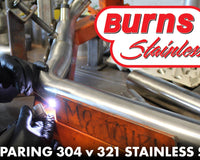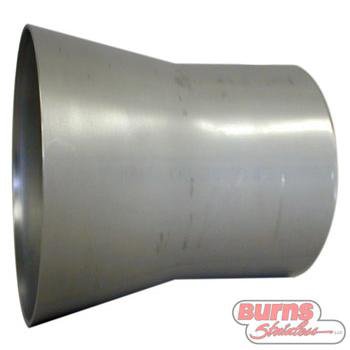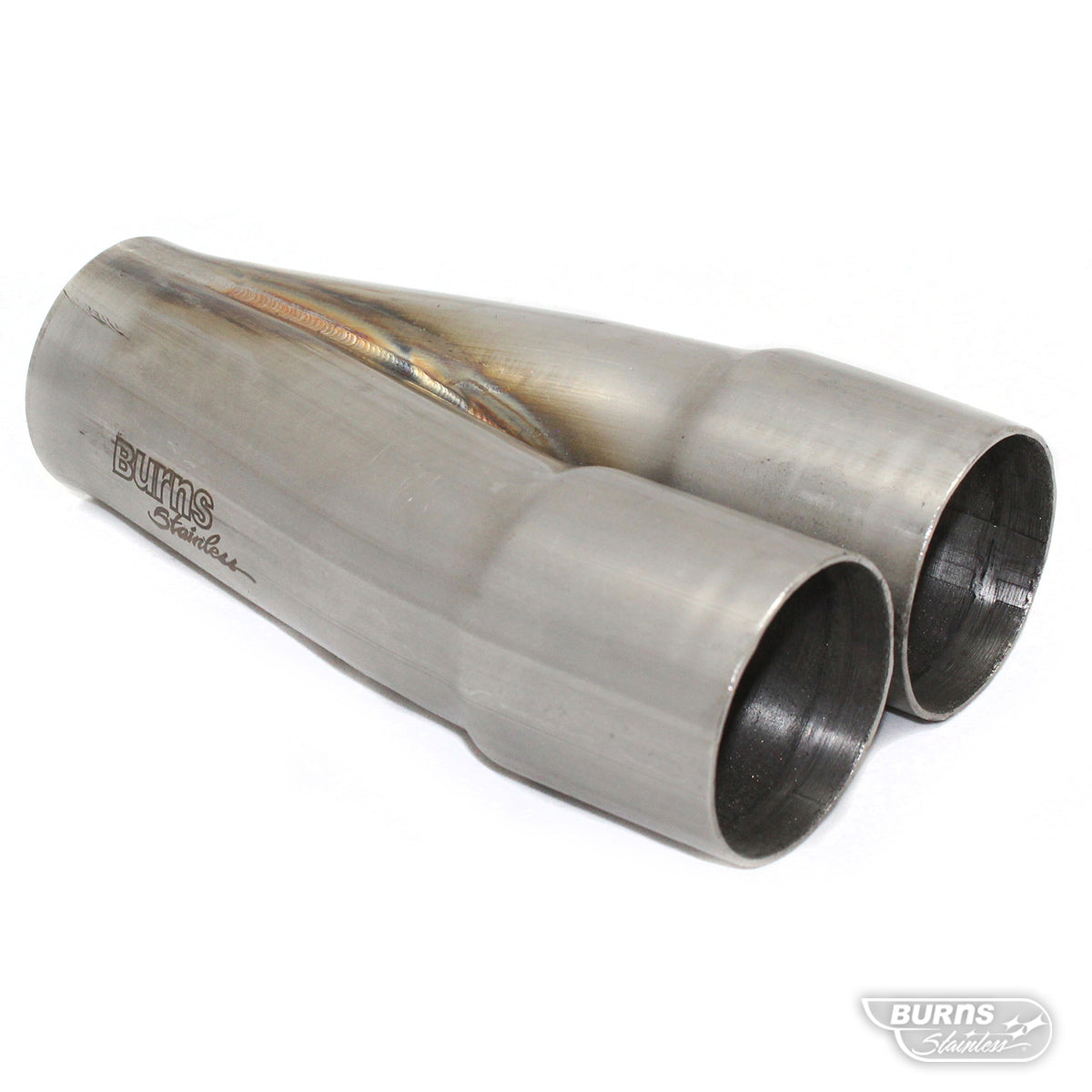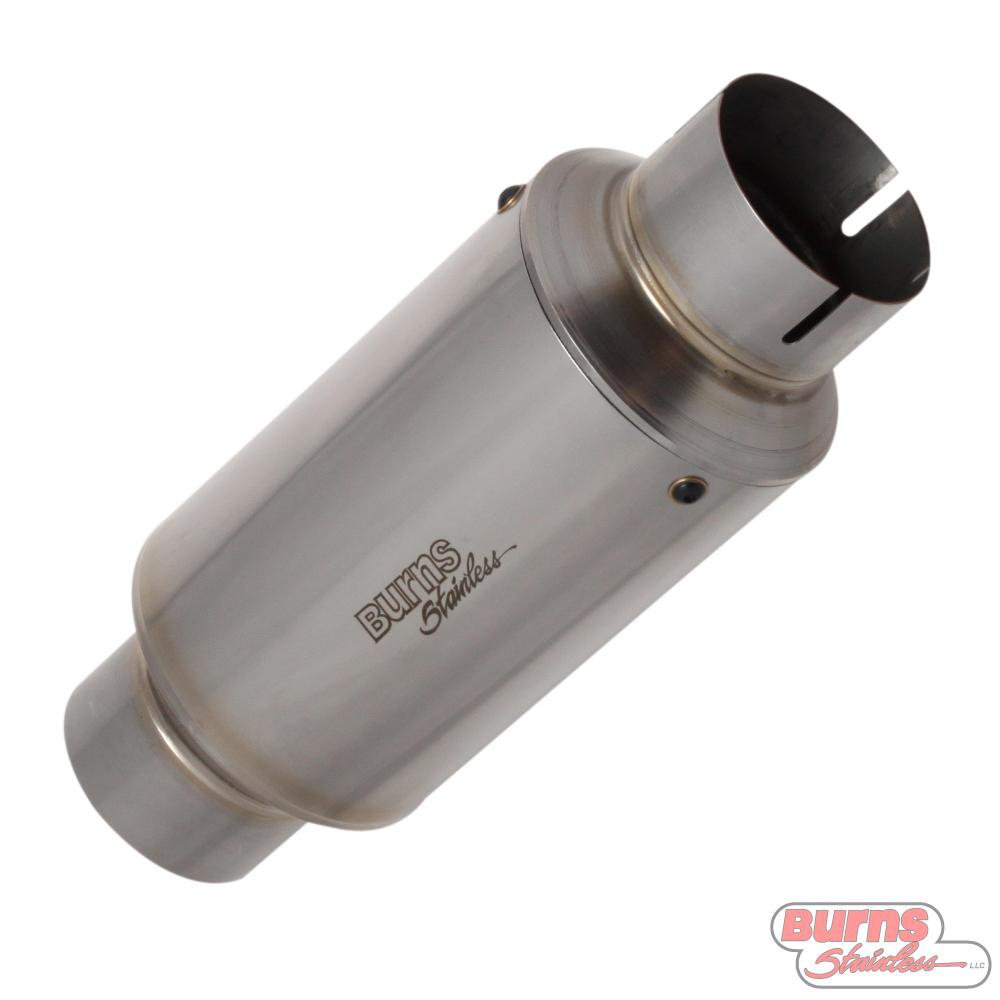We have our TIG welder ready to go. We have our header tubes tacked together with perfect fitment. We have properly fit the pipes to the flange and have our back purge system setup. So you may ask, are we ready to weld? Yes, we are finally ready to weld up the header. It is worth repeating that a well fabricated header is the result of many hours of diligent planning and preparation. I often get calls from customers who want to fabricate headers who tell me "I can weld stainless." Not to take away from the skills of a good welder, but the welding is only one step of a multi-step process.
SO HERE WE GO!
It is best to weld up each header tube independent of each other. This way you can get good torch access all around the tube. We prefer to hold the tube in a vise. It is usually not possible to weld a tacked joint in one pass. A small moveable bench vise works well as you can move the vice around by hand. If not, you can reposition the tube in a stationary vice. Next, install your back purging dams or stoppers to the tube and make sure that they fit snuggly. You do not want the stopper to come out in the middle of the process.
Next, you want to set the TIG to the proper settings. I get many calls from welders who want to know why their welds do not look like our welds (Figure 1). Many of them are properly back purging and are experienced welding stainless, but they complain that the welds are too dark. In almost every case, I find that they are trying to weld too fast and with too much heat. Slow down, and back-off on the welder amperage! Welding stainless with a TIG torch can actually provide you with a "spiritual" moment, so enjoy it. Your welds will be evidence of your success.
As mentioned in part 1 of this series, a 2%-thoriated tungsten electrode is preferred. When welding thin walled stainless, we use a 3/32" or 1/16" diameter electrode. A sharp electrode is a must (Figure 2), so sharpen the electrode using a grinding wheel making sure you do not inhale the metal dust as it is radioactive. As for filler rod, the rule of thumb is to use an equal or higher grade of stainless than the material you are welding. Our recommendation is to use 308 rod when welding 304SS. If you are joining a stainless tube to a mild steel flange, use a 309 rod, specially alloyed for dissimilar metals. Welds on 321 require a 347 filler rod. Note that by our rule of thumb, 347 welding rod could also be used to weld 304 or 304 to 321. We recommend 0.030" to 0.035" diameter TIG rod for 18 and 16 gage tubing.
Welding stainless requires use of DC current with straight polarity (electrode negative). The parameters for TIG welding are dependent upon tube wall thickness. For our Miller Sychrowave 250 welder, a setting of 35-40 amps works well for 16g or 18g stainless tubing. For 20 g, you will want to go down to 30-35 amps. You will want to fine tune the setting for your welder and technique. It is also a good idea to use a gas-diffuser (Figure 2) for the torch to provide a good distribution of shielding gas during welding.
Since the header tube needs to be as smooth as possible on the inside surface, we generally do not want 100% weld penetration as is customary in most welding practices. To compensate, weld beads need to be slightly convex to add strength to the weld (Figure 3). It should be noted that very thin-wall tubes (i.e. 20g or thinner) are often fusion welded. These projects should be left to the "ubër-welder." 
When you are ready to strike the torch, turn on the shielding gas, both for the torch and the back-purge system. We use a flow-rate of approximately 5 SCFH for the shield and 10 SCFH for the purge. Use good quality welding gloves and welding hood with automatic darkening lens. There are some pretty interesting helmets available (Figure 4). Once the arc is started and the weld pool is formed, carefully add filler rod while keeping an oscillating motion with the torch (Figure 5). For most cases, it is best to keep the torch at approximately 10 degrees off vertical. Add filler rod to the pool with your free hand while modulating the welding current with the foot pedal. If you can chew gum as well, go for it!
It is important to keep a constant speed to assure a good weld. When you come to the end of the weld, it is important to hold the torch on the weld after you have stopped the welding current. Your TIG shielding gas should continue to flow for a few seconds after releasing the foot pedal. This will help cool the weld in a controlled fashion. You will notice that the weld will be dark and dull and more apt to "crater" at the end if you skip this step. Cratering should be eliminated as it will be a stress riser and may lead to cracking. If you find that there is a crater in the weld, it is a good idea to do another pass near the crater. It is best to do this right-away while the metal is still hot. Continue welding all the joints in similar fashion. Remember, when you come to the last weld on a tube, you will want to stop the purge gas before welding. The combination of heating the gas and closing up the last "leak" could cause the stopper to blow-off, sometimes with a bang.
After you have welded all the primaries, it is time to fit them to the flange and weld. You may find when fitting the tubes into their jig that they may not fit the same way as they did when they were tacked together. This is because during the weld process, the tubes "moved." If you did a good job with your fitment, a little minor "encouragement" is all that is needed. If not, you will have to do a bit of "snake-charming." When you have fit up the tubes and the collector, tack them together and fit them to the car, or mock-up to make sure everything fits. It will be a lot easier to correct any misalignments before they are completely welded.
Last month we discussed the proper welding technique at the flange. Again, the thing to remember is not too much heat, especially when using stainless flanges. It is easy to warp a stainless flange by overheating. You will find that the tubes will "walk" due to flange warpage again requiring your "snake-charming" skills. Mild steel is much more forgiving in this respect, and many racing fabricators prefer to use a mild steel flange. Only the best welders get away without any warpage, so it is a good idea to "face" the flange on a disc grinder after welding to assure it is true. I hope that you have enjoyed this series of articles on header fabrication, and maybe even found it helpful. The staff at Burns Stainless is here to assist you with your exhaust fabrications needs. Please feel free to contact us if you have any questions on one of your projects. In future issues of the newsletter, we will discuss different header designs as well as look at some interesting headers we have seen over the years.










